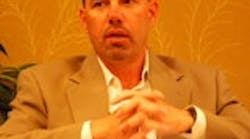Price isnt an end. Its a beginning. Although commercial transactions ultimately are denominated in dollars or euros or yuan, users and suppliers report that today's deepening supply-chain relationships go far beyond three bids and buy.
We used to just go with the low bid, but weve changed our focus to total cost of ownership, service diversity and e-commerce capabilities. Amerens Mark Brandt on the changing landscape of supply-chain priorities.
Imhoff led off by reporting that the overall supply chain environment is getting ever tighter worldwide. Whether were dealing with strategic materials, indirect support materials or support for capital projects, were dealing with markets that are unprecedented. So, the challenge is how we can secure what we need and leverage the supply chain in a way to make ourselves more competitive, said Imhoff. Weve found that, if we can figure out a way to play in this setting, its an opportunity for us to differentiate our company and better serve our customers, but it takes a lot of opportunism and creativity.
Walker added that the age-old challenge of just go and get the parts, which ABB thought it had solved in the past 20 years, has recently reemerged with a whole new set of capacity constraints. So suppliers are having to get their staffs to work closer together to serve customers more easily and find ways to get to that next level to deliver even better value, said Walker.
The panelists acknowledged that many users have been trying to shrink their supplier bases and that incumbents do have an edge, but they added that new suppliers can still participate if they can prove themselves able to deliver competitive products, needed services and new ideas.
We used to just go with the low bid, but weve changed our focus to total cost of ownership (TCO), service diversity and e-commerce capabilities, rather than just focusing on the competitive price, added Brandt. And suppliers have to deliver this total package, whether theyre working with our large strategic project group or our day-to-day procurement division. We also dont just take proposals into a back room anymore. Weve learned from our suppliers to be more collaborative and to get more data before a sourcing event. Even after an award is made, we show suppliers how our decisions were made and go over the high and low points of their proposals with them.
Imhoff also reported that Alcoa had reduced its supplier base, but added that one size doesnt fit all, and that successful proposals are 90% dependent on preparation. Before a decision to buy is made, we quantify other factors, such as if the supplier has an engineering center nearby and if they meet other useful metrics. Anyone that buys a box or cable needs to secure these metrics right up-front because theres no credibility if you try to get them after the fact. For instance, you need a robust TCO model that covers all the hard and soft criteria. Weve said we do TCO, but it was a mile wide and an inch thick, so we recently took a more detailed approach that brought in all the suppliers ahead of time.
Adams added that Weyerhaeuser has to look at value as well as price because it has limited funds for each project, so it has to make sure it also gets the reliability and equipment expandability it needs. We have to seek the best balance. We often dont take the lowest bid, but we usually cant buy top of the line either, said Adams. When we go to buy capital equipment, we form a team of plant and engineering people. They put together a weighted matrix for each purchase, and we calculate TCO and go over the data with the vendor, so everyone has a clear understanding of whats needed.
Adams said that during Weyerhaeusers 16-year relationship with ABB, its representatives regularly visit Weyerhaeusers plants, and that the forest products firms staffers also visit ABBs facilities in Europe. We talk to each other all the time, so there are no surprises.




